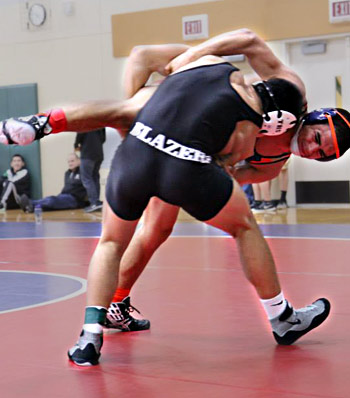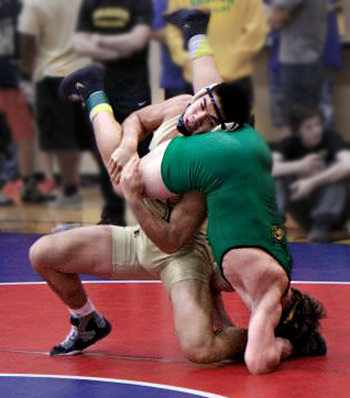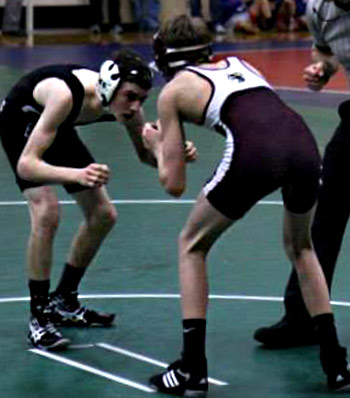Hole in the Clouds
Sep 6, 2009
There will come a day when nobody cares about Alabama football any more. True, we're not there yet. We'll probably have single-payer health care in the United States long before the Crimson Tide roll over and play dead.
As I write this, Alabama is losing its first game of the season 16-17, to Virginia Tech. They're playing in Atlanta tonight, in the Georgia Dome, but some sunny Saturday very soon, Bryant-Denny stadium in Tuscaloosa will once again look exactly like this.
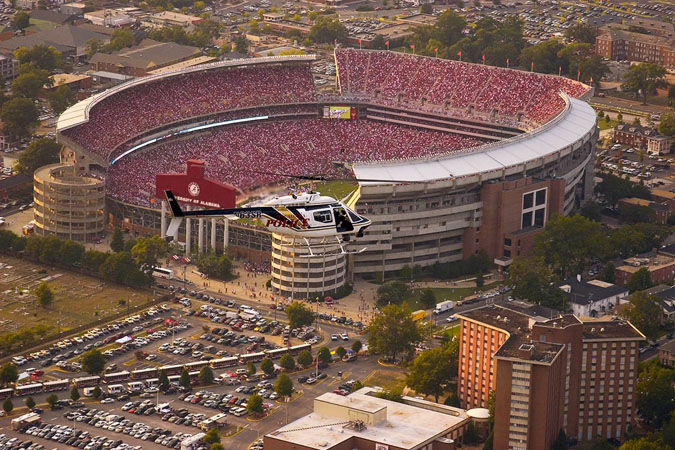
University of Alabama
Tuscaloosa
sports
football
Alabama
(Image credit: unknown)
Sep 8, 2009
In the summer of 1913, Hazel Reiber winds up for a pitch near the ocean in the big sandlot at Long Beach, Long Island. Her bathing costume looks skimpier than the outfits many women wore back then, but her boots would do just fine for a professional wrestler.
That is a baseball in her right hand, but I'm guessing--hoping--that the person she's throwing to is not swinging a bat. It doesn't look safe for slugging thereabouts.
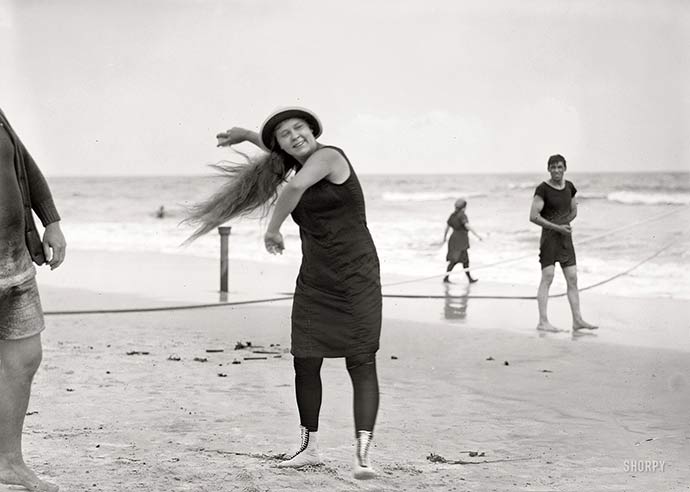
sports
New York
vintage
Long Island
beach
baseball
Hazel Reiber
(Image credit: Bain News Service, shorpy.com)
Aug 26, 2009
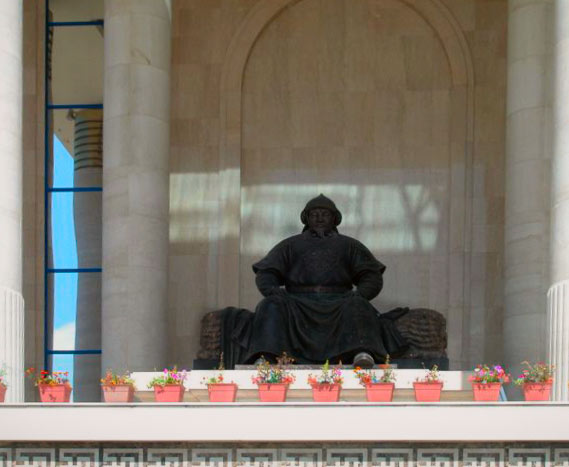
The 2009 Mongol Rally is history; the adventurers have arrived in Ulaan Bataar (or not), and most have now scattered to the winds. The intensity of the experience may have changed some lives, but not so much Steve and Tom, of Team Mad Lady. Here is their final blog post:
"So we only went and bloody did it didn't we!!
"Arrival party was brilliant fun - our pink blazers re-emerged, a bit more dusty, yet still with that touch of class! The beards we have been cultivating were a welcome addition!
"Was a great night, and a nice chilled day today is the perfect remedy for the nagging hangover! Looking forward to finding a pub to watch the Mighty Spurs this evening.
"So that is that. Final counts:
"-- Police stops - 7 (6 for driving offences - ST 3 TH 3 and one just for a police check)
"-- Bribes paid - not much. Couple of border controls we paid over the odds un-knowingly. Apart from that nothing. Great success!
"- -Tyre punctures/blow outs - 3 (ST 1 TH 2)
"-- Guages broken- 2 (Speedo for last 6/7,000 KM and fuel for last 1,000 KM)
"-- Cable ties used to hold Micra together! - about 15 as they ahd to be replaced a few times!
"-- Rivers crossed - 4 (and only got stuck in 1 - get ready for the video footage!)
"-- Keys locked in car - 1 (Well done Todster!). therefore break ins also 1!
"-- Wrong turns... Too many to count but reckon in the whole we were pretty well. Got a lot better when we realised the alternator interferred with the compass though!
"-- Packs of super noodles eaten - at least 8/10 each!
"-- Sweets distributed - 5kg!!! Toddy loved playing sugar daddy!
"Happy days!!, S&T"
sports
Ulaan Bataar
Team Mad Lady
soccer
Mongolia
Mongol Rally
Genghis Khan
Tom
Steve T
(Image credit: Mongol Rally)
Sep 16, 2009
At the Naval Academy, all the students, even the wrestlers, are required to attend all the home football games, They march in uniform from campus out to the stadium, where they parade onto the field by company and then march up into the stands, where they stand, literally, on their feet throughout the game. When Navy scores, plebes race down into the end zone and do pushups, one for each point scored.
But on parents' weekend, some of the students drift on out of the midshipmen's section of the stands to sit with their families like regular people--assuming that "regular people" is a fair term for lightweight wrestler Allen Stein and his good friend Mike Landis, the wrestling team's heavyweight. Mike was captain of his high school football team before limiting his energies to wrestling at the college level, but even without him in the lineup the Midshipmen did well last Saturday, beating Louisiana Tech 32-14.
In acknowledging the victory, the Academy superintendent awarded all the midshipmen an extra hour of liberty Saturday night, till 1 a.m. The wrestlers wasted that hour with the best of them.
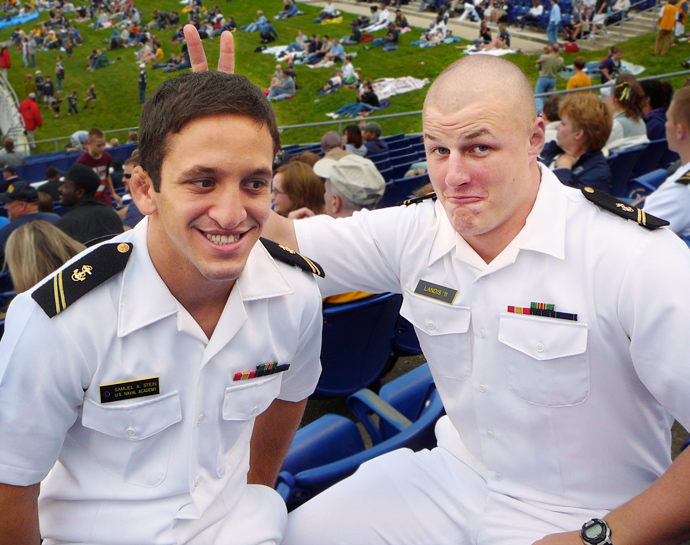
sports
football
wrestling
Navy
Annapolis
Mike Landis
Allen Stein
(Image credit: Ellen Stein)
Sep 21, 2009

In the small but earnest world of competitive badminton, the Chicago Open is a big deal, a tournament sanctioned by the body that will select the Olympic badminton team. Some of us forget that badminton is an Olympic sport.
Katrin Maldre is new to the competitive version of the sport and feared she wasn't yet playing at the Chicago Open level, but she took first place yesterday at this year's tournament. There were four divisions, from A, the strongest, through D, the weakest, and Katrin won the D division. Still, she noted, "the picture says it all."
What helped her compensate for badminton inexperience was a lifetime of athletic engagement. At the age of six, she was selected for intensive sports training by the Soviet athletic academy, and as a teenager she joined Estonia's national table tennis team, which competed in all the Soviet Republics across Europe and Asia. In recent years, she's played tennis, skiied, dabbled in recreational soccer, even tried a little bit of mountain climbing.
"There's just something magic about sports events," she says. "Also, while I play I don't eat, I get a lot of exercise, and I don't say any bad words, so I improve myself. And maybe that helps to improve the world a little bit."
sports
Chicago
badminton
Katrin Maldre
(Image credit: Katrin Maldre)
Aug 1, 2009

Last Saturday was the fourth annual Scott Fisher memorial soccer game, in which the Deering varsity soccer team plays Team Alumni as a fundraiser for the Vera Foundation, an organization devoted to teen suicide prevention. Scott Fisher was a Deering soccer player and honor student who died by suicide a few months after his graduation in 2005.
Players all wore wristbands with the number 8, Scott's number.
If Hank and Allen participate in this game again next year, they will both be playing on the alumni side. But this time they played against each other--Allen as an alumnus, Hank as a current Deering Ram. In this picture, that's Allen in white at the far left, and Hank in purple at the right. I failed to capture them both in action in a single frame, but at least here they are walking on the field at the same time. The game actually drew a good crowd; this view shows the visiting-side bleachers in the background, which were of course empty.
Usually, the alumni dominate these games. They are grown men, averaging at least 30 pounds heavier than the ever-hopeful teenage boys who challenge them. Also, there are dozens more alumni than there are current players, plenty of fresh legs. The young Rams do have a few advantages, however: they are in peak physical condition, their ball handling isn't rusty, and, unlike most of the alumni, they were wearing shin guards.
Alumni won the 2009 game, 4-1. That's not the score that matters domestically, however; what counts here at home is how the brothers scored against each other. This was a fine year in that regard; they tied, nil-nil.
sports
soccer
Allen Stein
Hank Stein
Vera Foundation
Deering High School
Scott Fisher
(Image credit: Ellen Stein)
Oct 13, 2009
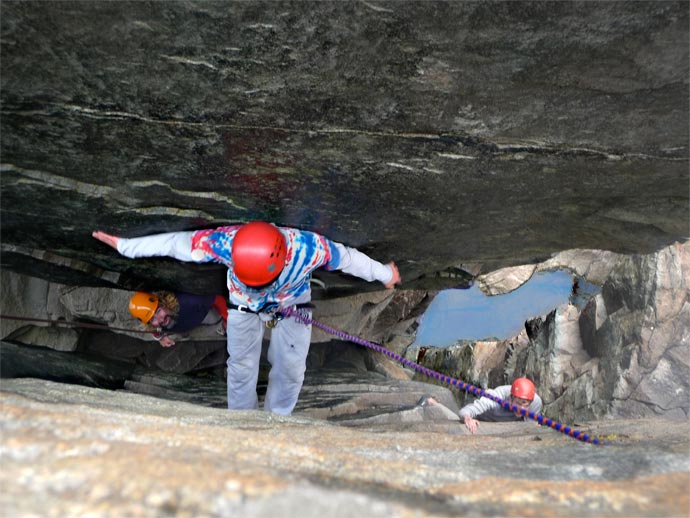
The Outdoors Club from Deering High School spent Columbus Day weekend camping at Acadia National Park and climbing the cliffs on Mount Desert Island. Here, Hank inches his way up a crack.
sports
landscape
Maine
Hank Stein
Acadia National Park
rocks
Oct 14, 2009
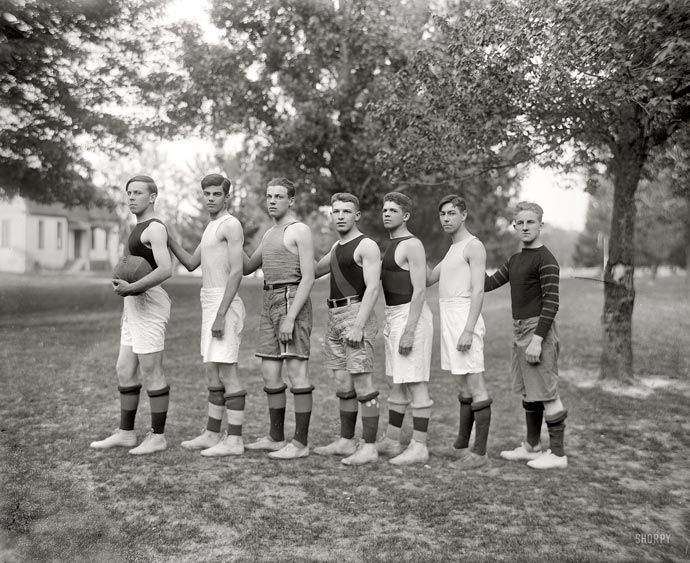
This is the 1905 varsity basketball team from Charlotte Hall Military Academy in St. Mary's County, Maryland. Sylvester Stallone was a Charlotte Hall boy, shortly before the school closed in the 1970s.
In 1905, basketballs had laces like footballs, and dribbling was very tricky.
sports
vintage
Charlotte Hall
Maryland
(Image credit: Harris & Ewing glass plate, via Shorpy)
Oct 18, 2009

The goalkeeper for Toronto FC, an MLS team, plays almost in the shadow of the city's CN Tower.
sports
soccer
Canada
Toronto
CN tower
(Image credit: Sam Javanrouh)
Oct 30, 2009
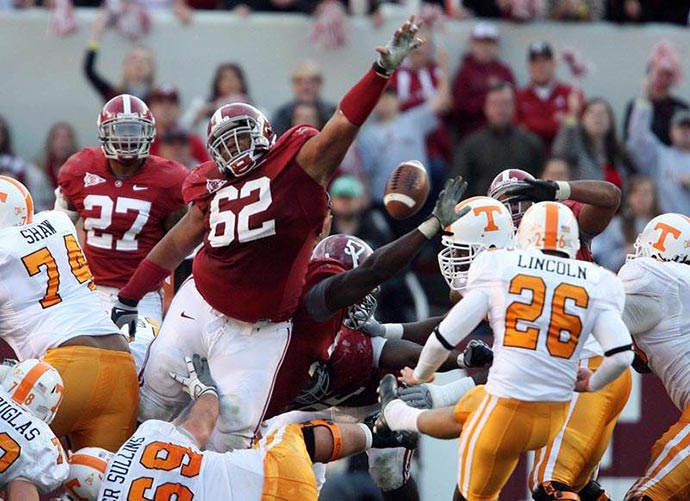
Please forgive me for writing here about Alabama football--just this once, I promise, at least till next year.
Some people don't like football. And even among those who do like football, some don't like Alabama football. All I can say is: better luck in your next life.
Nobody doesn't like Terrence Cody--Mount Cody--the unheralded defensive lineman from Mississippi Gulf Coast Community College who showed up for practice in Tuscaloosa weighing 400 pounds. Off the field, they say, he's a gentle, teddy bear sort of guy, who likes cartoons on TV and sleeps on Spiderman sheets. On the field, he's not gentle; Alabama's defense is ranked number one in the nation, and on that defense Cody has participated in more than his share of tackles and sacks. Last Saturday, he saved a close game for the Tide by blocking two field goal attempts, including one in the final seconds of the game.
But Mount Cody's value to the team doesn't really show up in the formal statistics. Basically, he is so big and strong that the opposing team will need two guys to contain him. This double-teaming gives his teammates a numerical advantage; because of Cody, somebody else is wide open to make more tackles and sacks.
Last Saturday, Tennessee put two guys on Cody, the Sullins brothers, identical twins who are big, strong, experienced offensive linemen. They each weigh something like 275 pounds. Cody has trimmed down a bit; even at 400 pounds he had moves, but now at 365 he can almost run. Still, he outweighed either of the Sullins boys by a good 90 pounds. Several times during the game, double-teaming didn't work to stop him; he would swat the first guy out of the way before the second guy showed up to help--and when Cody gets moving, it might take three or four guys to stop him.
Bama has a number ofl exciting players, including defensive linebacker Rolando McClain, who seems to be a football genius, always guessing right about what the other guys are going to do with the ball. On offense, there's the ridiculously fast receiver Julio Jones and the running back Mark Ingram, a sort of zombie runner who won't stay dead.
But last week was all about Mount Cody. Here he is, number 62, blocking a kick., Notice the Tennessee player lying down in front of him, number 69--that's one of the Sullins brothers, just trying to do his job.
Tuscaloosa
sports
football
Alabama
Crimson Tide
Terrence Cody
Mount Cody
(Image credit: Tuscaloosa News)
Oct 31, 2009
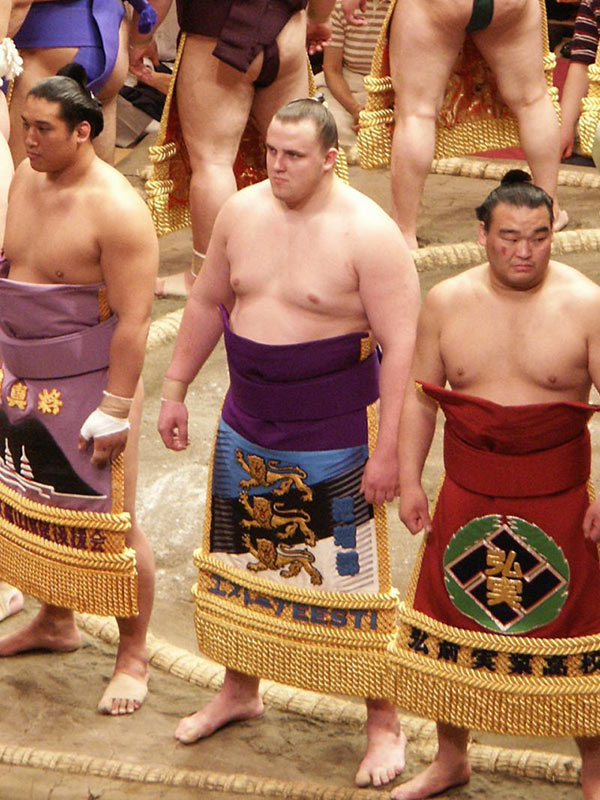
Kaido Hoovelson needed a stage name if he were going to get anywhere in the world of professional sumo wrestling; the name that stuck is Baruto, Japanese for Baltic.
Hoovelson was working as a nightclub bouncer in Estonia when his judo instructor suggested sumo as a good career move. Young men who are accepted into one of the "stables" of aspiring sumo wrestlers live and train together; they learn sumo technique and its cultural dimensions, and they get plenty to eat. Of course, newcomers--especially newcomers from foreign countries--could expect to be assigned chores, such as washing the clothes of the older wrestlers, and they would have to be tough enough to deal with hazing as well as wrestling.
But for Hoovelson to really succeed as Baruto, then first and foremost he would have to learn Japanese. His first word was "Itai": ouch. All instruction was in Japanese, as was all interaction day and night among the wrestlers in his stable. Within a couple of years, he became fluent enough to give TV interviews at tournaments, which turned out to be a good thing because he rose quickly to sumo stardom, even gaining his own fan club among young Japanese.
Beginning in the 1990s, a few foreigners have been among the 800 professionals working their way up the sumo ranks; two Hawaiians and a Mongolian have become champions of the topmost tournament league, Baruto, professional sumo's first Estonian athlete, is in the top league now and among the contenders for the overall championship.
In a profession of huge men, Baruto is among the tallest--6 foot 4--and as heavy as the heaviest--about 360 pounds. He has thrived on the Japanese meat stew that the wrestlers eat several times a day, but he has also sought out Western restaurants for a taste of home. In a Russian restaurant in Tokyo, he met Elena Tregubova from Vladivostok, the daughter of the proprietor. They were married last February, and Baruto insists he'd like to have five children with her.
A sumo match begins with several minutes of pacing and scowling. The actual fighting may last only a few seconds. It's all over as soon as one wrestler pushes the other out of the 15-foot circle or forces him to touch the mat with any part of his body other than his feet.
The picture shows Baruto participating in the ceremony associated with a sumo tournament. This video shows a match last month in which Baruto (in blue) needed only about 3 seconds to win; you can discern the finer points of his technique in the slow-motion replays at the end of the clip.
sports
Estonia
Baruto
Kaido Hoovelson
sumo
Japan
Nov 5, 2009

Sarah Stack, age 8, shoots and scores to lead her team to the Nashville city championship.
sports
kids
soccer
Sarah Stack
Nashville
Tennessee
Nov 9, 2009

Wearing headgear is always wise, but challenging your big brother to a wrestling match?
sports
Emily Wiggin
wrestling
Susan Wiggin
Bob Stein
Nov 20, 2009
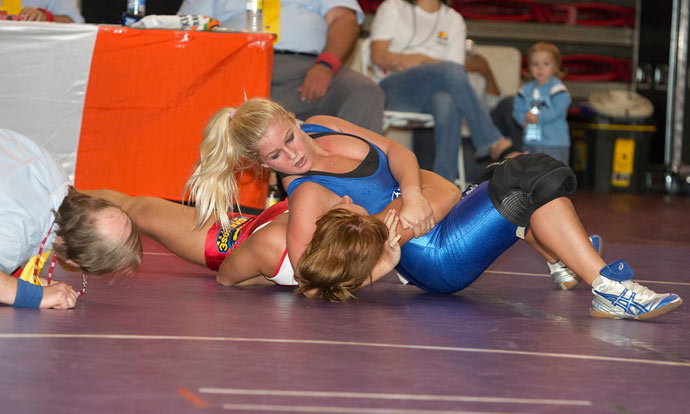
If this is November, then wrestling season must be upon us.
Instead of embarrassing my children and boring my kind readers with snapshots from sweaty school gymnasiums, I thought I'd introduce the season with a glimpse of women's wrestling, the newest Olympic sport.
The wrestler in blue, who appears to be on the verge of pinning her opponent in this 2006 match, is Deanna Rix, from South Berwick, Maine. In 2005, Rix almost made high school sports history, by coming within a few seconds in double overtime of winning a state wrestling championship against boys. Since then, she has been training at the New York Athletic Club and Olympic Training Center, supporting herself by waitressing at Hooters. She currently is the top-ranked American woman in her weight class (59 kg) and recently placed fifth at the world championship.
She may have trouble qualifying for the Olympics, however, because there are only four women's weight classes, and her fighting weight falls midway between two classes.
On the college level, women's wrestling has suddenly become popular; it is probably the fastest growing intercollegiate sport. Ten years ago, there were no women's wrestling teams; now there are more than 30. About half are "folkstyle" programs, following the same rules as men's high school and college wrestling in the United States; the other half wrestle "freestyle," using international rules. Although many of the women's programs offer athletic scholarships, quite a few, especially at small colleges, were introduced specifically in hopes of recruiting another dozen or so tuition-paying students.
Title IX has played a curious role in all this; for years, men's college wrestling has been in decline, with schools cutting programs, claiming that they needed to put more resources into women's sports, such as field hockey or gymnastics. Nowadays, some schools are finding they can revive men's wrestling by starting a women's team as well; MIT is one of the universities following this route. So far, the regrowth in men's college wrestling is concentrated in Division II and III schools, not at the top competitive level.
sports
wrestling
Deanna Rix
Jan 8, 2010

Alabama punt returner and cornerback Javier Arenas made a prediction in early December, about a month before the Tide defeated Texas in the Rose Bowl to claim its first national championship since 1992. "It will be," he said, "an extravagant moment."
Only he wasn't talking about taking a shot at the national title. He was referring to the commencement ceremony scheduled for Dec 12, when he would receive his college degree with a major in public relations, after just three and a half years at Alabama. In addition to completing heavy courseloads and winning national recognition on the football field, Arenas won awards for public service in Tuscaloosa, working with children in local schools and hospitals.
The only competition he lost was his race with his brother, who played football at Nebraska, to become the first college graduate in the family. His brother graduated last spring. "I'm second, but it's still a great honor," Arenas said. "From no one in our family graduating from college to now two college graduates--I'll take that any year."
Despite being one of the smallest players in Division I college football, at just 5-9, Arenas's football statistics ranked him high on the top-ranked team in the nation. Before the championship game, his total punt-return yardage was just a few yards shy of the national NCAA career record; with just one or two half-decent returns at the Rose Bowl, he would be able to set a new all-time record. But Texas wasn't taking any chances; every kick was directed to the part of the field farthest away from Arenas, even if it meant kicking out of bounds. He will leave Alabama still ranked as only the second-best punt returner in history.
Now, after last night's game, Alabama has the championship, its 13th in school history, and Arenas's teammate Mark Ingram has the Tide's first Heisman Trophy. Meanwhile, Javier Arenas, an all-American who almost certainly will be drafted early by the pros, has his degree. "If football doesn't work out," he said, "I'll be fine working in my field."
That's the way all college sports stories (and all cowboy movies) are supposed to go. Sometimes life imitates mythology.
University of Alabama
sports
football
Crimson Tide
Javier Arenas
Mark Ingram
Jan 29, 2010
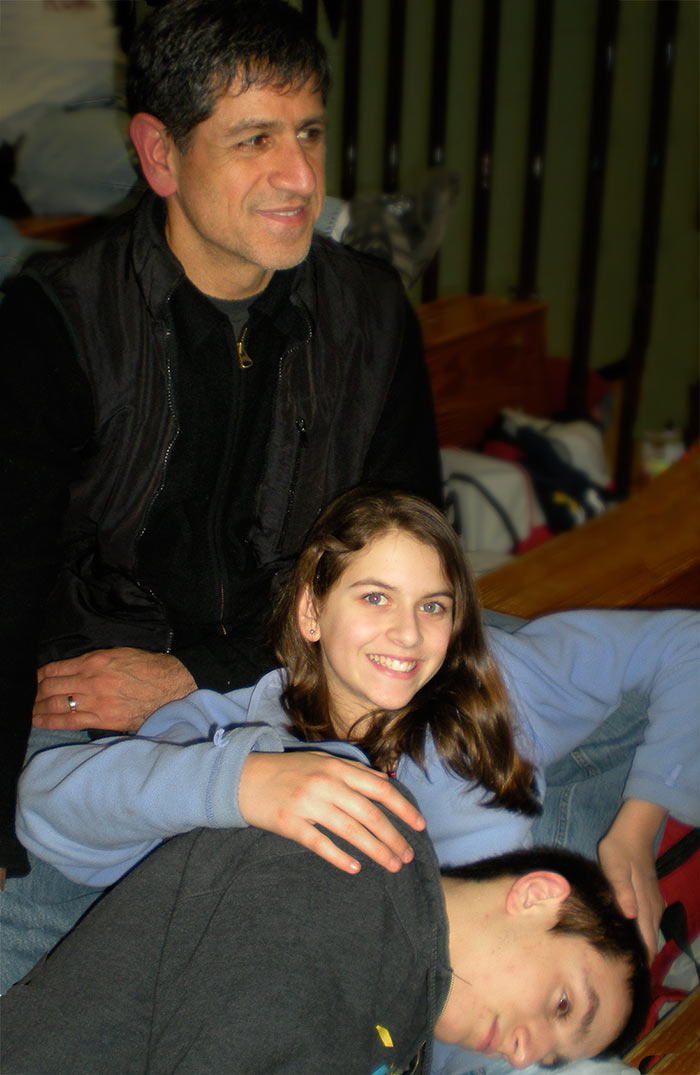
After a rough day on the mat last Saturday at the tournament in Essex Junction, Vermont, Arjan Nekoie settles down in the bleachers with his family while the remaining wrestlers battle it out. Arjan rests his head in the lap of his little sister Shadhi, who leans back in the lap of their father, Bahman.
sports
wrestling
Arjan, Shadhi, and Bahman Nekoie
Essex
Vermont
Feb 15, 2010
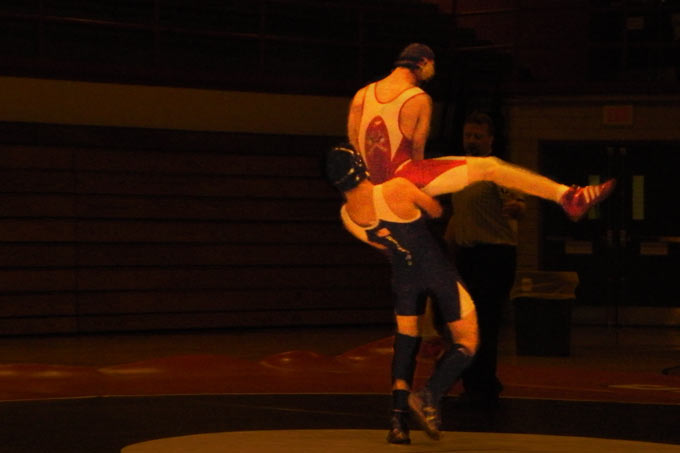
Saturday marked the end of the Maine high school wrestling season; it was also the end of Hank Stein's high school wrestling career. His senior season peaked at just the right time, leading up to a fourth-place finish in the state Class A tournament.
He celebrated Sunday morning by eating all the pancakes he could eat.
In this picture, from a December match against Sanford High School, Hank prepares to finish off his opponent.
sports
wrestling
Hank Stein
Deering High School
May 13, 2010
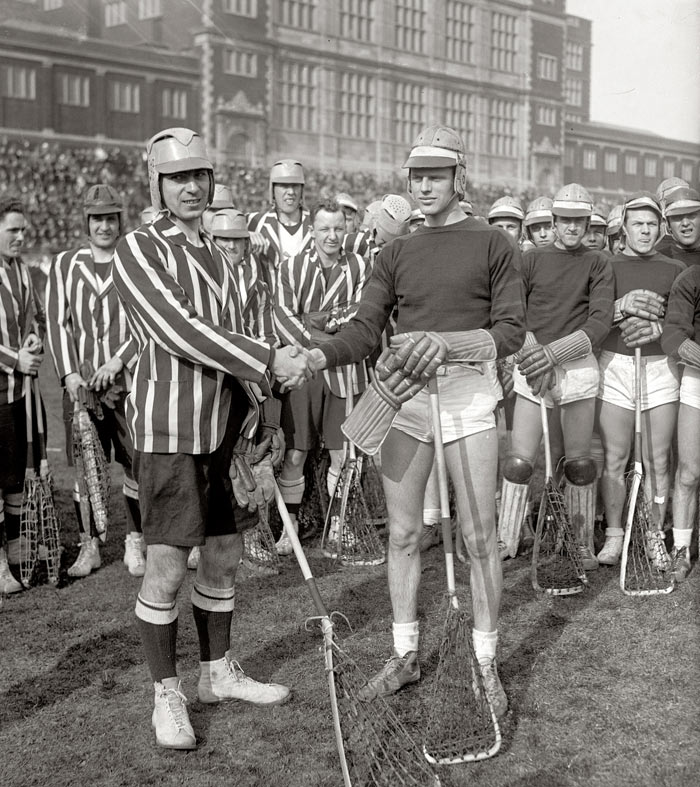
In 1930, a lacrosse team made up of players from both Oxford and Cambridge toured the United States, taking on all comers and thrashing them. Apparently, many of the Oxford-Cambridge stickmen were Americans studying abroad, including a number of Rhodes Scholars who had excelled at lacrosse during their undergraduate years.
Only one American team beat Oxford-Cambridge that season: the St. Johnnies from Annapolis, Maryland, shown here in short-shorts posing with the jacketed Englishmen in front of Washington, D.C.'s Central High School, where the game was played. St. John's won, 7-0.
St. John's College is now a super-intellectual "great books" school where students study the classics in the original Greek and have no time for intercollegiate sports. Every year, however, they do schedule one game against the athletic powerhouse located across the street from their campus in Annapolis, and they usually win handily. The game they play is croquet, and their opponents are the midshipmen of the U.S. Naval Academy, who complain that the Johnnies have all year to practice croquet, while midshipmen have to march and run and shine shoes and do all that other time-consuming navy stuff.
sports
Washington
Annapolis
Oxford-Cambridge
jackets
St. John's College
shorts
lacrosse
National Photo Company collection glass negative
Nov 15, 2010
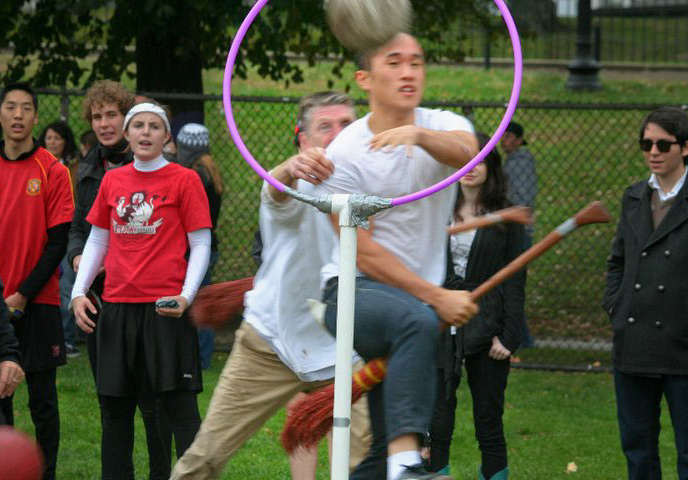
This past weekend, when 46 college quidditch teams from around the country gathered in New York City for the fourth annual International Quidditch World Cup, Portland's own Ben Nadeau, was right there on the pitch, representing Emerson College. Emerson placed second last year, falling to Middlebury in the finals, and hoped to go all the way this year.
College quidditch, much like the Harry Potter version, is a complicated game, played with broomsticks, of course, and also with multiple balls, hula hoops mounted vertically at the ends of an elliptical pitch, beaters, seekers, chasers, and a keeper and a snitch. The style of play has been compared to rugby, basketball, soccer, and dodgeball.
The game was devised about five years ago by Middlebury College students in Vermont, and Middlebury won the first three World Cups. But Emerson College, which practices and competes in quidditch on the Boston Common, has taken the sport especially seriously in recent years. Emerson students wrote the official quidditch rulebook (there are 700 rules) and field both intramural and varsity teams.
On Saturday, the first day of World Cup competition, Emerson sailed through pool play, beating some teams by more than 100 points. The NYU Hipster Hyperions fell to Emerson, 150-10. But Sunday afternoon in the quarter-finals, Tufts ended Emerson's season, 60-50. Tufts went on to lose to Middlebury in the finals.
Quidditch is a fast-growing activity--part sport, part tongue-in-cheek frolic, part recreation of childhood joy in the world of Harry Potter. Today's college students grew up with the Harry Potter books and movies. Will the game maintain its popularity with future generations of students, for whom Harry Potter is just part of the background of growing up, nothing new and exciting about it?
The young children who gather round the hoops at quidditch events, grabbing brooms and balls whenever there's a pause in the action to try learning the game themselves, all look eager to grow up and get their crack at playing real muggle quidditch someday. Maybe they will.
sports
Emerson College
Boston Common
quidditch
Jan 29, 2011
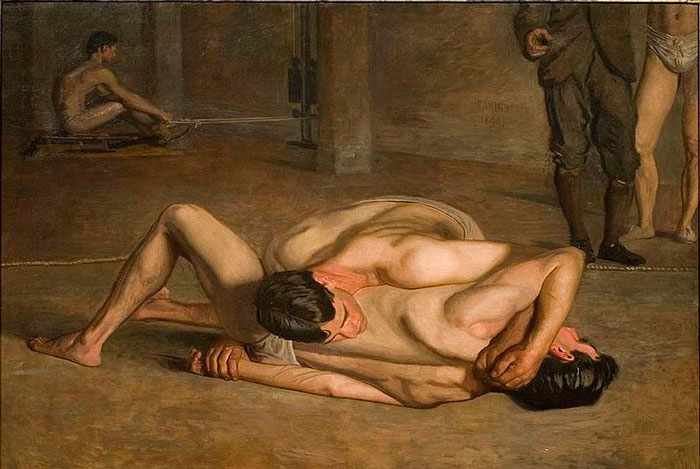 In the 1890s, when Thomas Eakins was teaching painting and anatomy at the Philadelphia Academy of Art, he spent a lot of time hanging around a local gym, watching the anatomy in action. This painting, "The Wrestlers," the final work in Eakins's sporting series, features not only a stylized moment in a wrestling match, very close to a final pin, but also some background characters watching and working and teaching and learning. In particular, the man in street clothes who is pointing at the wrestlers has been compared to Eakins himself--the coach in the gym, like the art instructor in the studio, draws attention to the wrestling action in hopes of elucidating salient matters of craft and human dynamics.
In the 1890s, when Thomas Eakins was teaching painting and anatomy at the Philadelphia Academy of Art, he spent a lot of time hanging around a local gym, watching the anatomy in action. This painting, "The Wrestlers," the final work in Eakins's sporting series, features not only a stylized moment in a wrestling match, very close to a final pin, but also some background characters watching and working and teaching and learning. In particular, the man in street clothes who is pointing at the wrestlers has been compared to Eakins himself--the coach in the gym, like the art instructor in the studio, draws attention to the wrestling action in hopes of elucidating salient matters of craft and human dynamics.
In 2011, meanwhile, wrestling season is again upon us, and one of the Stein wrestlers has stepped away from the gym for a few moments to share with us some observations about the Eakins wrestlers. "The guy on bottom," notes Allen, "should not be trying to peel the fingers off of the offensive opponent. He will be better off planting his right foot on the ground and arching on his head and trying to punch through back to his belly."
Coach in the background may be making the same point. But Mr. Eakins, the guy with the paintbrush--the guy in charge--apparently liked both these wrestlers exactly as they are.
sports
wrestling
art
Philadelphia
1899
(Painting by Thomas Eakins)
Feb 10, 2011
 Hank, in yellow, was the "customer" of a company that embroiders custom designs, such as team logos, onto anything you can think of--in this case, a Rumblebee! embroidered on a headband. The Rumblebees played ultimate frisbee last summer in a county league. Recently, Hank noticed that the embroidery company was offering discounts and other rewards in return for customer photos of the embroidered items in action. He sent them this photo, and they sent him fifty dollars and put his picture onto the front page of their website.
Hank, in yellow, was the "customer" of a company that embroiders custom designs, such as team logos, onto anything you can think of--in this case, a Rumblebee! embroidered on a headband. The Rumblebees played ultimate frisbee last summer in a county league. Recently, Hank noticed that the embroidery company was offering discounts and other rewards in return for customer photos of the embroidered items in action. He sent them this photo, and they sent him fifty dollars and put his picture onto the front page of their website.
Hole-in-the-Clouds, of course, endorses nothin', embroidered or otherwise. But I can't help but feel a warm spot in my heart for any company that concludes that featuring the image of one of my children will be good for business. Especially if they offer to pay for my child's image. So I'll drop my scruples down around my ankles and share the link.
Yes, Hank's face was painted yellow--something to do with team spirit. And yes, right after the picture was snapped, the guy in green punched Hank in the face as he sent the frisbee flying. It was not intentional, sez Hank. The guy is a nice kid, a former high school wrestler who is currently attending Maine Maritime Academy. They may meet again next summer, faces painted, headbands embroidered, ready for Ultimate combat. Go, Rumblebees!
sports
Hank
ultimate frisbee
headband
marketing
Mar 25, 2011
 There are two kinds of trekking in Nepal: teahouse trekking through populated countryside and tent trekking, which can venture into uninhabited mountain realms of rock and ice. Both kinds involve a group of tourists walking on trails for days or weeks, led by a guide and supported by porters.
There are two kinds of trekking in Nepal: teahouse trekking through populated countryside and tent trekking, which can venture into uninhabited mountain realms of rock and ice. Both kinds involve a group of tourists walking on trails for days or weeks, led by a guide and supported by porters.
The trekkers in the group usually carry only daypacks as they walk, containing bottled water, a fleece and rainjacket, toilet paper, and little more. Porters for teahouse treks carry duffels containing clothes and sleeping bags; for tent treks, they also carry food, camping gear, and perhaps mountaineering equipment. For a teahouse trek, there is one porter for every two or three trekkers in the group. For a tent trek, the ratio may be much higher.
Porters are ridiculously strong, fit, sturdy, reliable people. Most but not all are male, though they are not big men; some are barely five feet tall. They load up with 60 or 80 or even 100 pounds on their backs and oftimes finish the day's hike long before the lightly-laden trekkers. Many of them come from extremely remote villages, where subsistence farming is still the mainstay of life and there is little or no opportunity to earn cash income. Many porters, like most Nepalis, are illiterate. Work with the trekkers is seasonal and extremely irregular, and the pay is poor.
The two porters who accompanied our little group came from the Forbidden Kingdom of Mustang, high in the Himalayas near the Tibetan border. The provincial government of Mustang keeps the district almost closed to foreigners by charging so much for visas that only the wealthiest tourists can visit. Each year, as trekking season comes around, would-be porters in places like Mustang have to somehow come up with cash money--often borrowed--for bus fare to Kathmandu, where they gather in the airport parking lot to be looked over by trekking guides and perhaps chosen for work.
The guide for our group, Binaye, a Nepali who usually worked for a German tour company but who handled our trip on his own, went out to the airport to hire porters a few days before we were scheduled to arrive. He knew nothing about the two men he chose and had never met them before; he liked their attitude, he said, and they didn't smell of booze. From their homes in Mustang, they had walked four days to the bus stop and then ridden the bus for three days to Kathmandu, with no guarantee of work.
Both of them were among the pleasantest, hardest working people I've ever met.
After three days' trek, we reached the village of Ghorepani, a trekking hub. Many routes lead out from Ghorepani into the high Himalaya around Annapurna. The place bustled with trekkers coming and going, and over the years, trekking-related income had apparently led to public amenities not evident in smaller villages. Ghorepani had electricity and a medical clinic of some kind, and also a school.
Outside the school was a playground, a paved yard with a basketball goal and a volleyball net. Mule trains and horse caravans trooped across the back of the lot. Wastewater from a restaurant kitchen spilled in from the front.
As we settled into town to catch our breath and wait for dinner, porters were out in the playground playing volleyball. They had set down their loads, taken off their boots, and somehow found the energy to run and jump and dive and enjoy the late-afternoon sun.
Porters and trekkers eat separately and mostly have little communication or contact; per tradition, we come together for drinks the last night of the trip. That's when I learned that Beem, the porter with a hat and scarf and permanent smile, had five children, just like me.
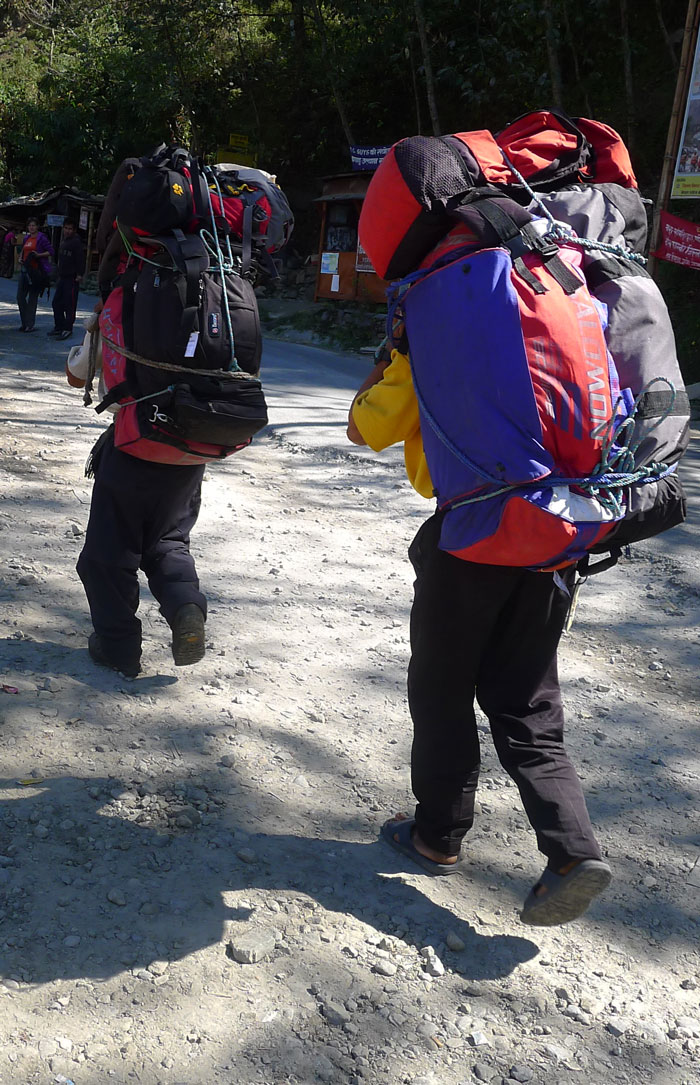
sports
Nepal
work
trekking
Ghorepani
Beem
volleyball
porters
Apr 28, 2011
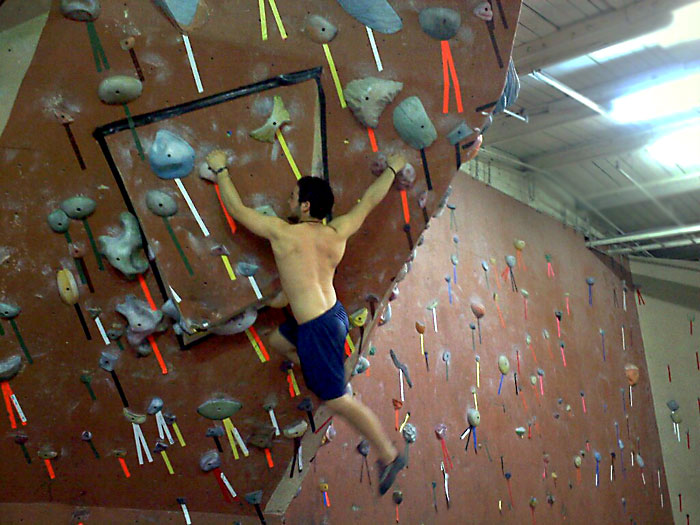 Hank swings his way up the wall in the climbing gym. Rock climbing has become a passion of his lately, but he says that climbing in a gym is not nearly as pleasant and exciting as climbing cliffs and boulders outdoors in the fresh air.
Hank swings his way up the wall in the climbing gym. Rock climbing has become a passion of his lately, but he says that climbing in a gym is not nearly as pleasant and exciting as climbing cliffs and boulders outdoors in the fresh air.
sports
Hank
gym
rock climbing
(Image credit: S.A. Stein)
May 16, 2011
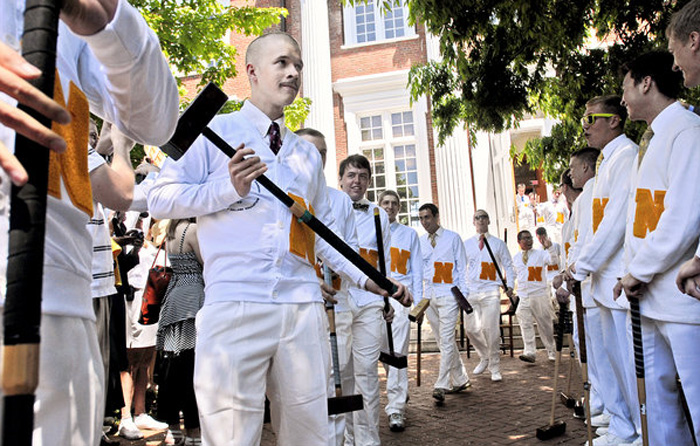 Every April, the town of Annapolis, Maryland, gears up for the annual croquet match between the Midshipmen of the Naval Academy and the Johnnys of the small liberal arts college across the street, St. John's.
Every April, the town of Annapolis, Maryland, gears up for the annual croquet match between the Midshipmen of the Naval Academy and the Johnnys of the small liberal arts college across the street, St. John's.
Although the Naval Academy is an athletic powerhouse and St. John's is a haven for bookworms, the Johnnys routinely win the contest. But there is a non-athletic dimension to the event as well: costuming.
Spectators from both colleges show up in Gatsby-esque 1920s attire, notably including hats. And the St. John's team dresses in different uniforms every year, top secret till the day of the game.
This year, the Johnnys' secret uniform was . . . the same as the Naval Academy uniform, white pants with letter sweaters. The two teams were distinguishable, however, because the midshipmen wore shiny white dress shoes while the Johnnys wore whatever shoes they felt like wearing.
St. John's won, 3-1.
sports
Annapolis
spring
St. John's College
Naval Academy
croquet
Jun 3, 2011
 Like most American local governments, the city of Philadelphia is pretty much broke and can't afford to operate its public swimming pools.
Like most American local governments, the city of Philadelphia is pretty much broke and can't afford to operate its public swimming pools.
Two summers ago, the pools never did open. Last summer, neighborhood fundraising financed a few weeks of swimtime in July and August. This summer, we're told, fundraising has been successful enough to open the pool in our neighborhood for a few extra weeks, beginning in mid-June when school lets out.
Rumor has it that one Philadelphia neighborhood is financing its pool operation with a high-stakes Cowpie Bingo game. If you're not familiar with Cowpie Bingo, it's really one of the best games you can play with a rented cow. You mark a grid on a small field of grass and sell chances on squares in the grid; half the take goes to the cause–in this case, lifeguard salaries and tanks of chlorine–and the other half goes to the lucky person who bought the square where the cow deposits whatever she deposits.
The Philadelphia swimming pool cowpie bingo game is said to offer $10,000 to the winner, if the cow cooperates by depositing her pie neatly within a single square of the grid.
This may or may not prove a good financial model for twenty-first-century urban government. Until we know for sure, that No Diving thing is probably a really good idea.
sports
Philadelphia
swimming
neighborhood
empty
Jun 7, 2011
 At the University of Montana, students can earn academic credit for assignments like this. Hank got an A last semester in Intermediate Rock Climbing.
At the University of Montana, students can earn academic credit for assignments like this. Hank got an A last semester in Intermediate Rock Climbing.
sports
landscape
Hank Stein
mountains
rocks
rock climbing
Montana
Jun 11, 2011
 When our four-year-old neighbor went to the baseball game Monday night, she got to wear her Phillies dress, and she got to hang out with her preschool buddy, who wore his Incredible Hulk shirt. And not only that, the Phillies beat the Dodgers.
When our four-year-old neighbor went to the baseball game Monday night, she got to wear her Phillies dress, and she got to hang out with her preschool buddy, who wore his Incredible Hulk shirt. And not only that, the Phillies beat the Dodgers.
sports
baseball
children
neighbors
Philadelphia Phillies
Jun 23, 2011
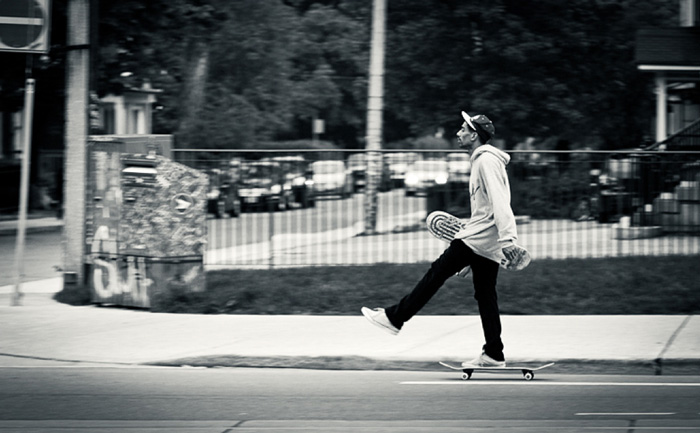 Believe it or not, yesterday was Go Skateboard Day in Toronto, where this fella was truckin on down College Street.
Believe it or not, yesterday was Go Skateboard Day in Toronto, where this fella was truckin on down College Street.
sports
Canada
Toronto
streetscape
Ontario
skateboard
(Image credit: Sam Javanrouh)
Jul 4, 2011
 When I imagine a perfect Fourth, there would be water splashing in the afternoon, then hot dogs, watermelon, blueberry shortcake–or maybe boiled crabs, potato salad, corn on the cob–and finally sparklers and fireworks. In the air, at some point, there could be band music and lightning bugs and American flags.
When I imagine a perfect Fourth, there would be water splashing in the afternoon, then hot dogs, watermelon, blueberry shortcake–or maybe boiled crabs, potato salad, corn on the cob–and finally sparklers and fireworks. In the air, at some point, there could be band music and lightning bugs and American flags.
And a little bocce would be very, very nice. I don't know the people in this picture, who claim that they went up and down the coast of California playing bocce all along the way; this scene is from their stop in Sonoma County. A whole road trip of bocce is excessive–there's something way too over-the-top-West-Coast about it–and the guy on the right does appear to be wearing his beer can on top of his hat.
But the guy on the left has perfect form: bocce ball in one hand, beer in the other. Happy Birthday, America!
sports
landscape
California
bocce
Fourth of July
Sonoma County
game
Jul 10, 2011
 Soccer is popular in Nepal, even if the fields are more dirt than grass, and this year the national team, known as the Ghorkalis, is on a roll. Last week, Nepal notched two victories, 2-0 and then 5-0, in 2014 World Cup qualifying matches against East Timor. The Ghorkalis have a new coach, Graham Roberts, an Englishman who played for Tottenham and Chelsea, mostly on defense, and won six caps for England.
Soccer is popular in Nepal, even if the fields are more dirt than grass, and this year the national team, known as the Ghorkalis, is on a roll. Last week, Nepal notched two victories, 2-0 and then 5-0, in 2014 World Cup qualifying matches against East Timor. The Ghorkalis have a new coach, Graham Roberts, an Englishman who played for Tottenham and Chelsea, mostly on defense, and won six caps for England.
Meanwhile, in league play, defending champions Nepal Police Club holds a comfortable lead in the Martyrs Memorial Red Bull Division A, though Yeti Air Himalayan Sherpas Club is not out of the running.
The field shown here is in the suburbs of Kathmandu, at the base of the hill topped by the Monkey Temple.
sports
soccer
cityscape
birdseye view
Nepal
Kathmandu
view from Monkey Temple
Jul 23, 2011
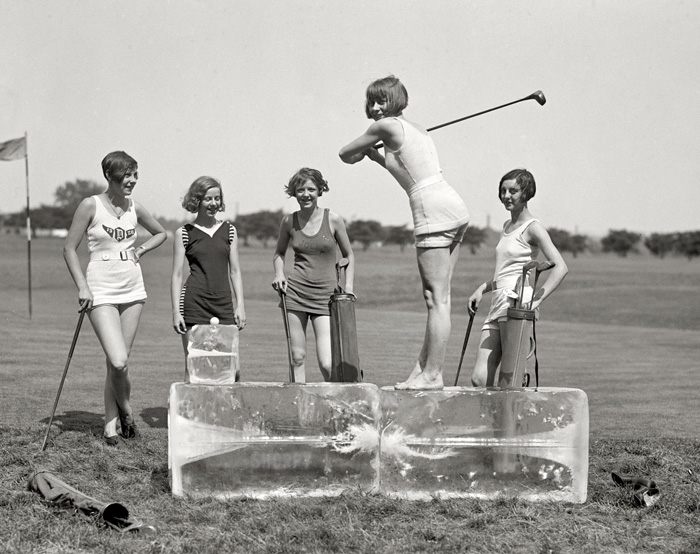 On July 11, 1926, the Washington Post published this publicity shot for "the Gladyse Wilbur girls," a song-and-dance troupe that did its singing and dancing, as well as its teeing off, in bathing costumes. That's Dorothy Kelly on ice, backed up by Virginia Hunter, Elaine Griggs, Hazel Brown, and Mary Kaminsky.
On July 11, 1926, the Washington Post published this publicity shot for "the Gladyse Wilbur girls," a song-and-dance troupe that did its singing and dancing, as well as its teeing off, in bathing costumes. That's Dorothy Kelly on ice, backed up by Virginia Hunter, Elaine Griggs, Hazel Brown, and Mary Kaminsky.
The show was in Keith's Theater in Washington, which may have been air conditioned by 1926. The ice in the photo is obviously intended to suggest that the Gladyse Wilbur girls can be enjoyed in cool comfort, even in the middle of the summer.
sports
Washington
summer
ice
Virginia
Dorothy
bathing suits
District of Columbia
Elaine
golf
Mary
Hazel
(Image credit: National Photo Company, via Shorpy)
Nov 19, 2011

This is something new for Philadelphia, and perhaps for the American urban scene in general: a permanent concrete ping pong table, with paddles and balls stored underneath, recently installed in the grass strip alongside Benjamin Franklin Parkway, about halfway between city hall and the art museum.
sports
cityscape
fall
streetscape
park
ping pong
table tennis
(Image credit: Janet Goldwater)
Feb 20, 2012
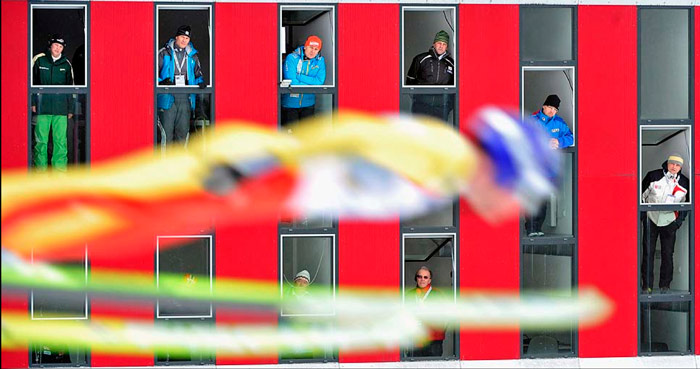 The judges assess the form of this ski jumper as he flies past the referees' tower during last week's Team Tour World Cup competition in Klingenthal, Germany. No winners were named; high winds forced an early halt to the event.
The judges assess the form of this ski jumper as he flies past the referees' tower during last week's Team Tour World Cup competition in Klingenthal, Germany. No winners were named; high winds forced an early halt to the event.
sports
Germany
snow
ski jump
Klingenthal
(Image credit: LA Times)
Feb 6, 2013
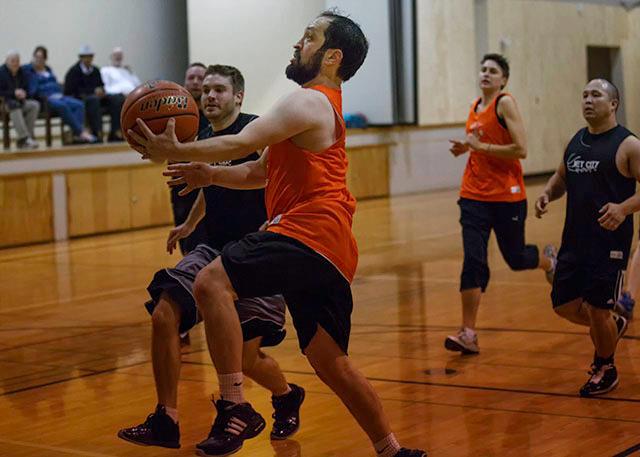 John "JJ" Stein goes up for what we assume has got to be a basket in league play with Seattle's Jet City Hoops in the gym at the Asian Resource Center.
John "JJ" Stein goes up for what we assume has got to be a basket in league play with Seattle's Jet City Hoops in the gym at the Asian Resource Center.
It's hard to know for sure, but the row of spectators sitting on stage might just be dazzled by the play of JJ and the other Cheetahs. Or their presence may reflect their interest in one of the Asian Resource Center's other resources.
sports
family
Seattle
JJ Stein
Jet City Hoops
Asian Resource Center
basketball
Apr 7, 2013
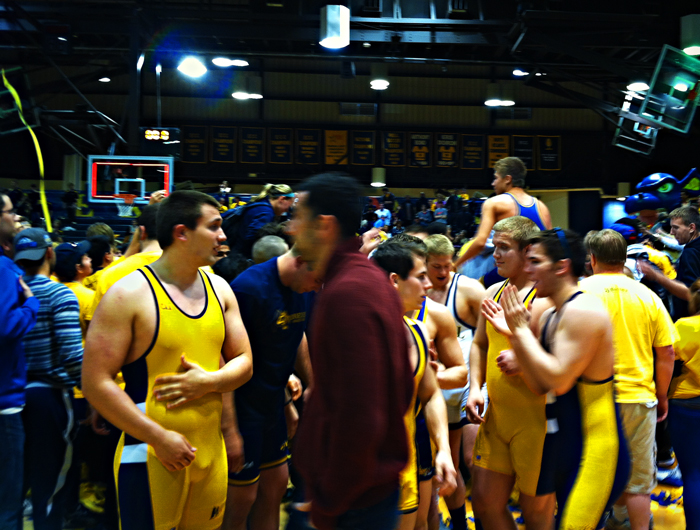 After Drexel's women's basketball team won the National Invitational Tournament on Saturday, beating the University of Utah in the final seconds of the game, students poured onto the court to celebrate.
After Drexel's women's basketball team won the National Invitational Tournament on Saturday, beating the University of Utah in the final seconds of the game, students poured onto the court to celebrate.
Yes, that's the wrestling team down in front, but they'd come to cheer the Lady Dragons, not to rassle. They were wearing their singlets in a team effort aimed at winning $250 being offered by the athletic department to whichever of Drexel's non-basketball teams showed the most spirit at the game. The wrestlers didn't win–the prize went to the women's crew team for their dragon-themed "Feel the Fire" display, complete with sideways tilted baseball caps–but in our opinion, everybody who dresses in a singlet at a basketball game is a winner. And the wrestlers, whose season on the mat ended a few weeks ago, looked well-fed and frisky on the hardwood.
The basketball was championship-caliber as well. Utah led until late in the second half, when Drexel caught up but never could pull ahead by more than a point or two. With 21 seconds to go, Utah again had the lead and the ball. But one Drexel woman managed to tip Utah's throw-in, another snagged the ball, a third drove to the basket for a layup through traffic, and they all won their program's first post-season championship.
sports
wrestling
Philadelphia
basketball
Drexel University
May 3, 2013
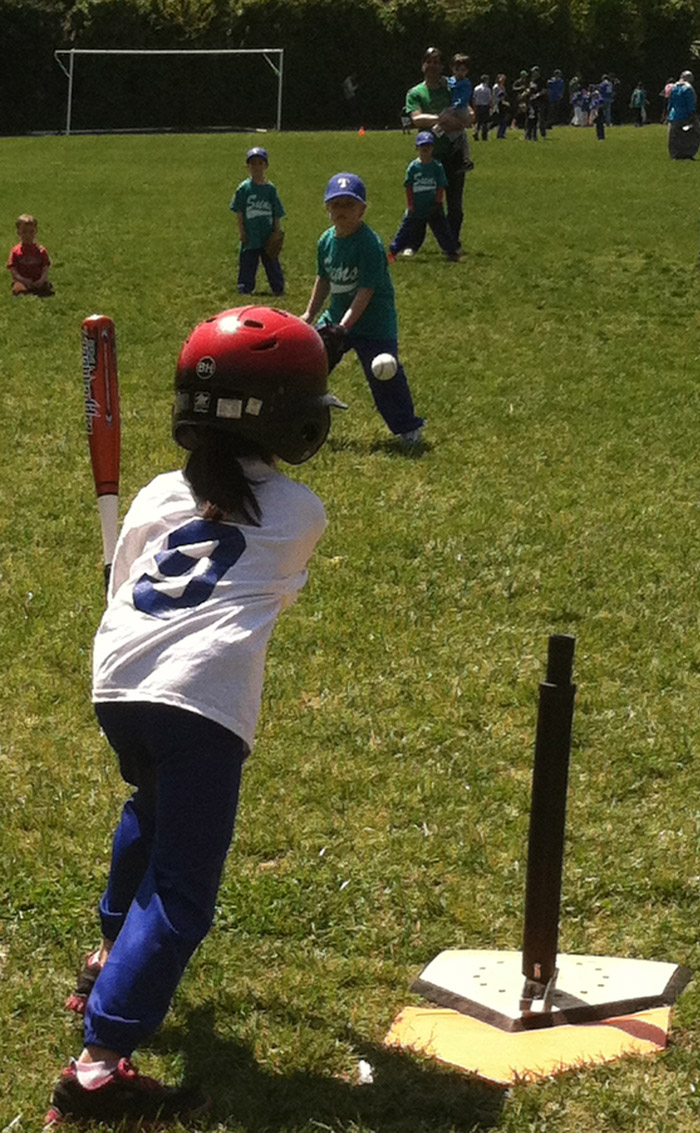 It's t-ball time at Taney Field in Schuylkill River Park.
It's t-ball time at Taney Field in Schuylkill River Park.
sports
children
Philadelphia
Schuylkill River Park
neighborhood
Lily
t-ball
Jul 30, 2013
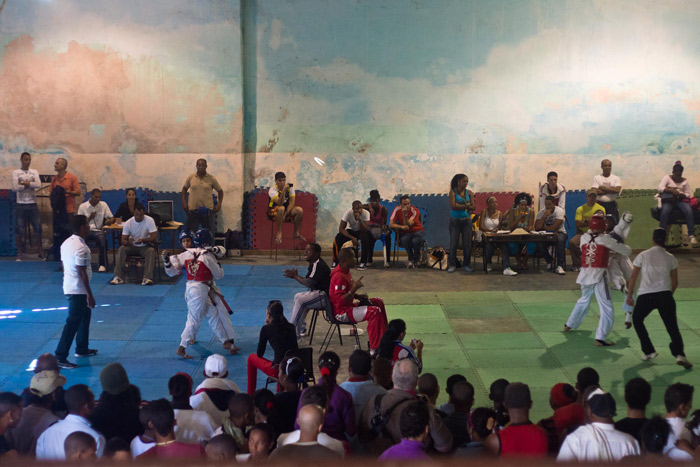 Taekwon-Do tournament in Havana, Cuba.
Taekwon-Do tournament in Havana, Cuba.
sports
children
Havana
Cuba
gym
Taekwon-Do
(Image credit: Peter Sills)
Nov 30, 2013
 Juniper Self, shown here with her mother Daphne, came dressed to cheer at Bryant-Denny Stadium last week for her first Alabama football game. The Crimson Tide beat University of Tennessee–Chattanooga, 49–0.
Juniper Self, shown here with her mother Daphne, came dressed to cheer at Bryant-Denny Stadium last week for her first Alabama football game. The Crimson Tide beat University of Tennessee–Chattanooga, 49–0.
Today's Iron Bowl game at Auburn is for all the marbles. Roll Tide Roll.
Tuscaloosa
sports
football
Alabama
Daphne
cheerleader
Juniper
(h/t: Scott Self)
Feb 17, 2014
 Marco's rock is right on track for the U.S. of A.
Marco's rock is right on track for the U.S. of A.
sports
streetscape
winter
snow
ice
Kater Street
neighborhood
Marco Bonnes
Olympics
broom
(Image credit: Little Fuji)
Aug 12, 2014

Next week, for the first time in Little League history, a team of 12- and 13-year-olds from the city of Philadelphia will be playing in the World Series in Williamsport, PA.
They are our Taney Dragons, who play at Taney Field in our neighborhood's Schuylkill River Park. To wangle an invitation to the big dance, the Dragons had to pull off a string of upsets, becoming the first Philly team ever to win districts, to win regionals, to win states, and then last week to win the Mid-Atlantic championship.
The way Little League works, it's almost always the well-funded suburban operations that come away with the postseason prizes. Taney had to raise money all year long to go out for these tournaments; they scrounged for practice fields all over the city, sometimes using a hangar out by the airport. Many of the parents can't afford to travel to watch their kids play, but they managed to raise $20,000 in a few days to send the team to Connecticut for the Mid-Atlantic tournament.
The Dragons' victory in Connecticut was a stunner; they dispatched Newark, Delaware, last year's Mid-Atlantic champions, 8-0. Their bats were hot, obviously, but their pitching was pretty much the same as always: a cool clinic of 70-mile-an-hour fastballs and heartbreaking curveballs, a shutout with just three hits allowed by the Dragons' star Mo'Ne Davis, who will be the only girl this year in the Little League World Series.
Although Little League has permitted girls to play since it was forced to by the courts in 1974, Davis is still a rarity. She says she has never pitched to a girl batter. But baseball is not really her passion; that would be basketball, her favorite sport. Her dream is to play in the WNBA.
Meanwhile, she's the Dragon who gets all the attention, which may be a good thing since she's unflappable, never discouraged or distracted, nothing at all like a typical 13-year-old. It's the boys on the team who crank up the drama, along with the energy level.
Tune in on August 15 on national TV for the Dragons' first World Series contest, against a team from South Nashville, Tennessee.
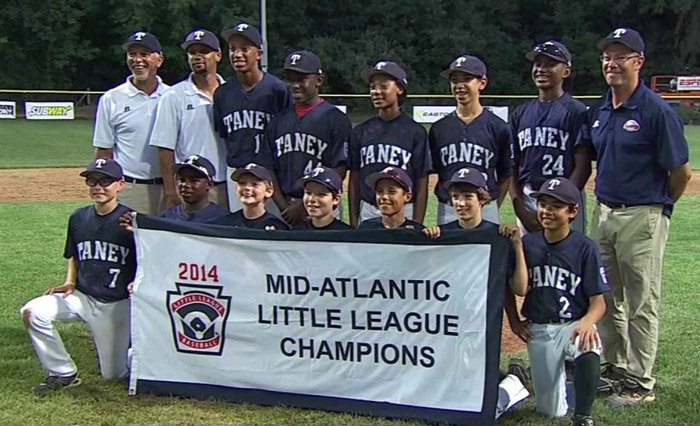
sports
baseball
neighborhood
Philly
Mo'Ne Davis
Taney
Little League
Nov 3, 2014
 Back in June, the women working behind the counter at this ice cream place in Germany took a break to watch the German national team win the 2014 World Cup in Brazil.
Back in June, the women working behind the counter at this ice cream place in Germany took a break to watch the German national team win the 2014 World Cup in Brazil.
Next June, there will be another soccer World Cup competition, this time hosted by Canada and featuring women's national teams. Last month in Philadelphia, the U.S. women officially qualified for the 2015 tournament by beating Mexico 3-0 and then Costa Rica 6-0 to claim the regional CONCACAF Cup. A clear majority of the 12,000-plus spectators cheering them on were women and girls.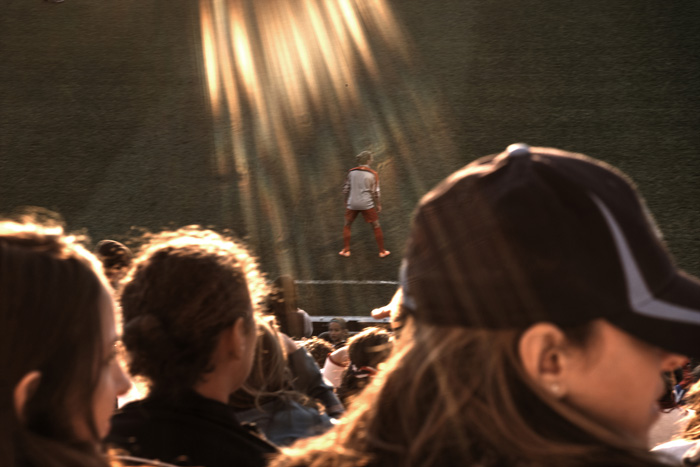
sports
soccer
Germany
work
Concacaf Cup
women's sports
World Cup
(Image credits: top, Sang Wenjin; bottom, Fuji T)
Nov 23, 2014
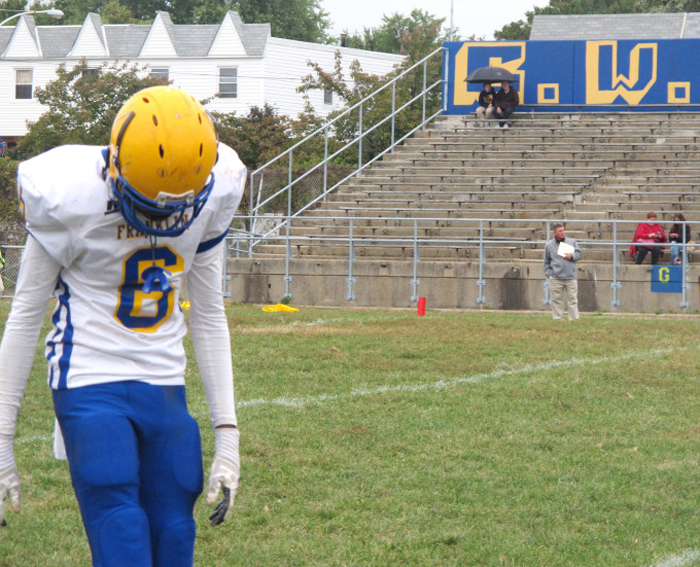 The posture of number 6, who's been playing football this season for the Electrons of Ben Franklin High School, is ambiguous. Perhaps he's a kicker focusing on the ball on a tee; perhaps he's just unhappy about something in the game, or something unrelated to the game. Certainly, he's not celebrating.
The posture of number 6, who's been playing football this season for the Electrons of Ben Franklin High School, is ambiguous. Perhaps he's a kicker focusing on the ball on a tee; perhaps he's just unhappy about something in the game, or something unrelated to the game. Certainly, he's not celebrating.
But the evening the picture was taken, on Philly Photo Day in mid-October, the Franklin Electrons won a big game; they beat perennial city powerhouse George Washington–at G.W.–on their way to an undefeated regular season and a Philadelphia Public School AAAA championship.
Had the picture been snapped this weekend, however, interpretation would be straightforward. Yesterday, Franklin, the public high school champion, faced off against Saint Joseph's Prep, the city's Catholic school champion and last year's state champion. The Hawks of Prep crushed the Electrons, 44-27.
The magic is over now; there will be no trip to states, no undefeated miracle season. Still and all, they made a pretty good run of it, those Electrons of 2014.
sports
football
Philadelphia
high school
George Washington High
Franklin High
(Image credit: Denise Johnson)
Nov 30, 2014
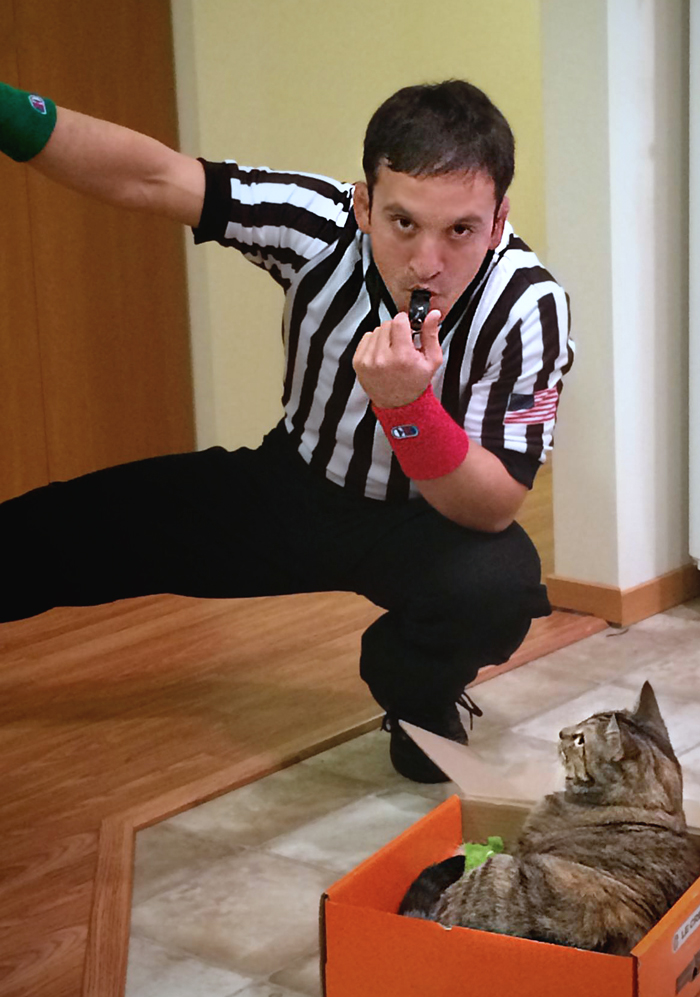 Long before football season has wound down, the winter sports are upon us. Basketball and hockey are in full swing, but what we see here is wrestling, or rather wrestling refereeing, as demonstrated for the enlightment of Ruby the cat, who chooses not to reveal whether or not she has chosen enlightenment.
Long before football season has wound down, the winter sports are upon us. Basketball and hockey are in full swing, but what we see here is wrestling, or rather wrestling refereeing, as demonstrated for the enlightment of Ruby the cat, who chooses not to reveal whether or not she has chosen enlightenment.
sports
wrestling
Allen
cat
Seattle
Ruby
(Image credit: Amy Gipsman)
Jan 29, 2015
 When last we spent our Saturdays at high school wrestling tournaments, back in the decade of the twenty-oughts, we were parents of wrestlers, which meant that we were working the concession stand or down on our knees with a camcorder or scanning the scene from the bleachers, looking for indications of wrestling drama.
When last we spent our Saturdays at high school wrestling tournaments, back in the decade of the twenty-oughts, we were parents of wrestlers, which meant that we were working the concession stand or down on our knees with a camcorder or scanning the scene from the bleachers, looking for indications of wrestling drama.
We can report with confidence that in the winter of 2015, all the drama is still much in evidence. Even before you enter the gym, you can't help but notice the kid standing all by himself out in the cold parking lot, hiding his face, struggling not to cry.
The only big difference nowadays is that somehow, magically, our wrestlers from way back then have returned to this scene as what might be called wrestling facilitators. One of them is now a referee with striped shirt and whistle, and another is an assistant assistant coach, a guy who sits in the corner of the mat during each bout and yells, "Circle! Circle! Good–keep that elbow. That's all right, don't worry, now up and out!"
High school wrestling matches last six minutes, except when they're over in a few seconds. That can happen when a newbie, with panic in his eyes, is up against an experienced wrestler who knows a few moves. Of course it can also happen when an experienced wrestler underestimates an opponent, or when he forgets for an instant to do or not do something critical that he knew perfectly well he was supposed to do or not do.
The drama actually begins before the wrestling even starts. Kids wearing hoodies pace back and forth in front of the bleachers, headphones clamped on their ears, eyes focused in some alternate universe. They're trying to psych themselves up, or calm themselves down, or both.
By the time they strip off the hoodie and walk out to the center of the mat, some of them already look destined to lose. They've heard something about their opponent that scares them, or they just know from lessons learned the hard way that their performance will likely be disappointing. They may surprise themselves, they really may win, but their posture and eye movements are already broadcasting what they figure are the dismal odds against them.
Other kids work hard before the match at presenting body language that says something different: "I'm the man," or "You're dirt," or "I will break you." They're swaggering out there, playing the part in the script that they want for themselves; maybe it will work, maybe it will backfire, maybe it won't matter at all. But there's no wrestling without broad drama.
From the stands, kids cheer on their teammates and yell at them to shoot. They talk smack with each other and steal each other's drinks and snacks and pretend not to give them back. Some of them are smartasses. Some are trying to nap. They're high school kids, and it's a Saturday.
And on display in the gym are adolescent bodies of every imaginable size and shape, all looking at least a little bit goofy in those singlets. There are little guys with twigs for limbs, and thick-necked muscle-bound jocks, and mountainous heavyweights with serious guts and no necks at all. No other high school forum welcomes all these physical specimens, offers them all a chance, however slight a chance, to be a hero.
Among the hundreds of boys are a few girls. During our years as wrestling parents in Maine, there were girls on some of the teams, and they wrestled boys, occasionally with some success. This year in western Washington, girls appear to be a bit more numerous on the mats, and they wrestle one another.
We attended the Marysville Premier tournament, in the company of the Blazers from Timberline High School in Lacey, Washington. Four girls wrestle for the Blazers, alongside a couple of dozen boys. They all wear black singlets unless they make it to the tournament finals, when they dress in special gold singlets decorated with a double-bladed axe, their school logo.
Three Blazers wore gold in Marysville, and one of the three won his final match to claim the tournament championship at his weight class. The next week, at the Jaguar Invitational tournament in Puyallup, four Blazers took championships, and in the 126-pound weight class, the two wrestlers in the finals were both Blazers.
The regular season is winding down now, leading up to regionals and then states. Go Blazers! Shoot! Shoot!
sports
Washington
wrestling
gym
Marysville-Pilchuck High School
singlets
Timberline High School
Marc Julagay
Fuji T)
(Image credits: Hank Stein
Apr 26, 2015
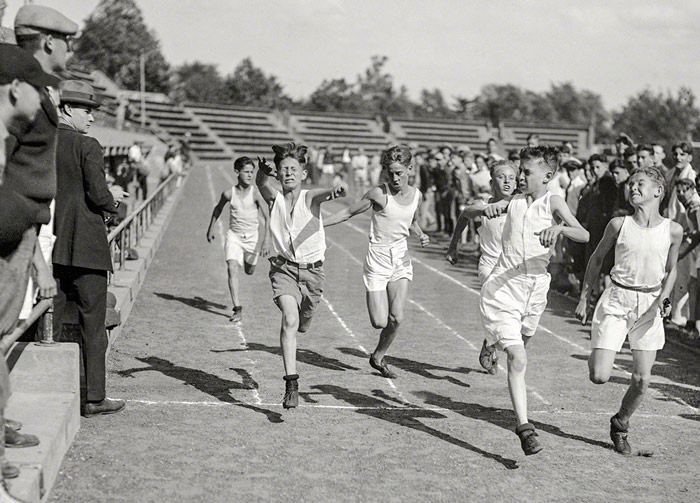 Runners lunge across the line in the 60-yard dash, 80-pound class. This race was won and lost on September 6, 1924, on the track in back of Central High School, Washington, D.C.
Runners lunge across the line in the 60-yard dash, 80-pound class. This race was won and lost on September 6, 1924, on the track in back of Central High School, Washington, D.C.
sports
children
Washington, D.C.
running
competition
track
1924
(Image credit: National Photo Company via Shorpy)
Mar 14, 2016
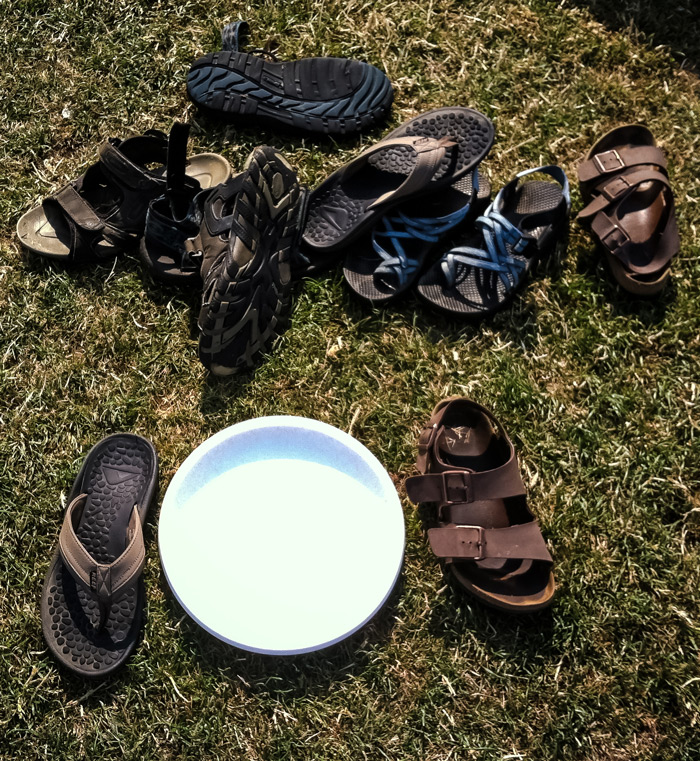 Even in organized tournaments, an ultimate frisbee game generally features no referee or scorekeeper. Teams call fouls on themselves and keep track of the score using a spare frisbee and a jumble of shoes; after each goal, a shoe is moved to one side or the other of the frisbee, depending on which team made the score. When this picture was taken early in a game at the 26th annual Potlatch tournament over the July 4th weekend in Redmond, Washington, the score was tied, one up.
Even in organized tournaments, an ultimate frisbee game generally features no referee or scorekeeper. Teams call fouls on themselves and keep track of the score using a spare frisbee and a jumble of shoes; after each goal, a shoe is moved to one side or the other of the frisbee, depending on which team made the score. When this picture was taken early in a game at the 26th annual Potlatch tournament over the July 4th weekend in Redmond, Washington, the score was tied, one up.
Despite what seems obvious from this picture, ultimate frisbee players don't usually compete barefoot. Out on the field, they wear soccer cleats or running shoes.
And if the goal scoring should happen to outpace the number of available scorekeeping shoes, one shoe can be turned sideways to stand in for five vertical shoes, much as tick marks are slashed sideways in bundles of five.
The Potlatch is among the largest tournaments in the ultimate frisbee world, with teams coming to compete from as far away as Korea, Alaska, and the east coast of North America. In the game being scored above, the Garden Gnomes of Olympia, Washington, eventually fell to a team from San Francisco; the Gnomes have changed their name to O'School and signed up to try again at the 2016 Potlatch.
sports
summer
ultimate frisbee
shoes
grass
score
Olympia, Washington
Apr 9, 2016
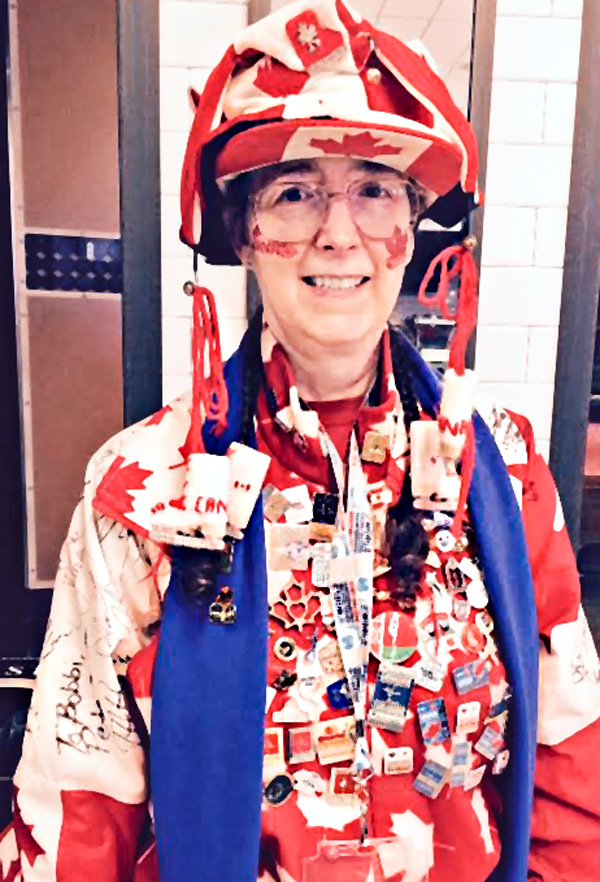
Last week saw the finals of the 2016 World Figure Skating championships, and needless to say, Bobbi Cochar was there for every minute of every program. Ever since she sat rinkside at the Canadian national championships in Ottawa in 1984, this Toronto native has never missed a major skating event, no matter where on earth the venue might be.
She cheers on her Canadians, of course, two of whom, Megan Duhamel and Eric Radford, did skate away with the gold medal last week in the pairs category. But Cochar is really there for all the skaters, making sure that every single one of them receives one of her trademark needlepoint skate ornaments as she or he goes out on the ice, along with a personal note of encouragement and thanks.
Skating looms large in Cochar's heart, especially since her diagnosis with multiple sclerosis at the age of 28. She had always been a noncompetitive dancer, and after her diagnosis, she was stunned to realize that she could still skate, even performing complicated moves and routines. "But once I was off the ice," she recalls, "I couldn't walk to save my life."
Multiple sclerosis has since cost her the hearing in one ear and the color vision in one eye, though the doctor who predicted she'd never walk again was incorrect. She skates six days a week now, four days for her work with the CanSkate program and two days on her own, just because she can.
Until recently, Cochar's mother, also a longtime ice dancer, traveled to skating events with her. The two of them collected autographs on their jackets from skaters all over the world, and took personal responsibility to make sure that anybody at all who was brave enough and hard-working enough to go out there and skate their hearts out in front of a crowd would go home with words and tokens of appreciation from skating's unrivaled superfans.
sports
Canada
Boston
Bobbi Cochar
fans
ice skating
(Image credit: Carol Fuchs)
Jan 9, 2017
 It was halftime on a cold November day in 1950, and things just didn't look good for this high school football team in the locker room at Freeport Municipal Stadium in New York.
It was halftime on a cold November day in 1950, and things just didn't look good for this high school football team in the locker room at Freeport Municipal Stadium in New York.
Tonight, at halftime of the college football national championship game being played on national tv, will one of the locker rooms feel like this? Probably not; tonight's game–a rematch of last year's championship final between Alabama and Clemson–is expected to be close.
Alabama won last year, but barely. Our hearts are with them again this year, though we wouldn't bet the rent on it. Rammer Jammer.
sports
football
Long Island
high school
locker room
Freeport, NY
halftime
(Image credit: Walter Albertin for the New York World Telegram and Sun, via Shorpy)
Jan 16, 2018
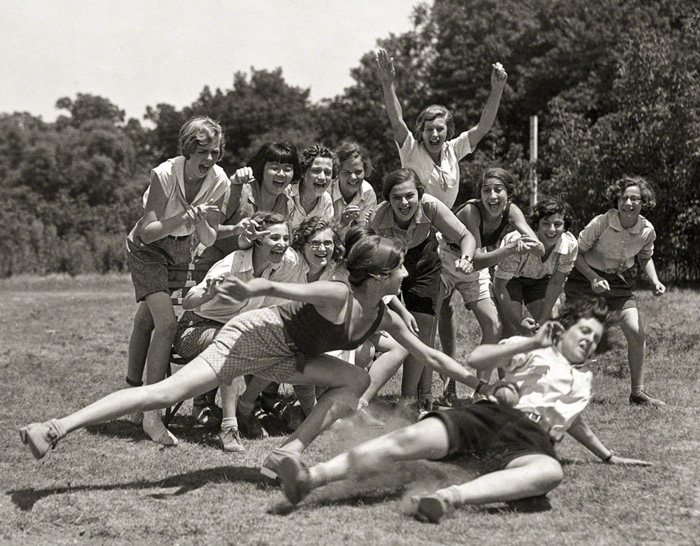 Posing for an action shot in a softball game at a Y camp in Plano, Illinois, 1930.
Posing for an action shot in a softball game at a Y camp in Plano, Illinois, 1930.
sports
summer
1930
softball
Plano, Illinois
(Image credit: Wittman Bros. via Shorpy)
Mar 16, 2018
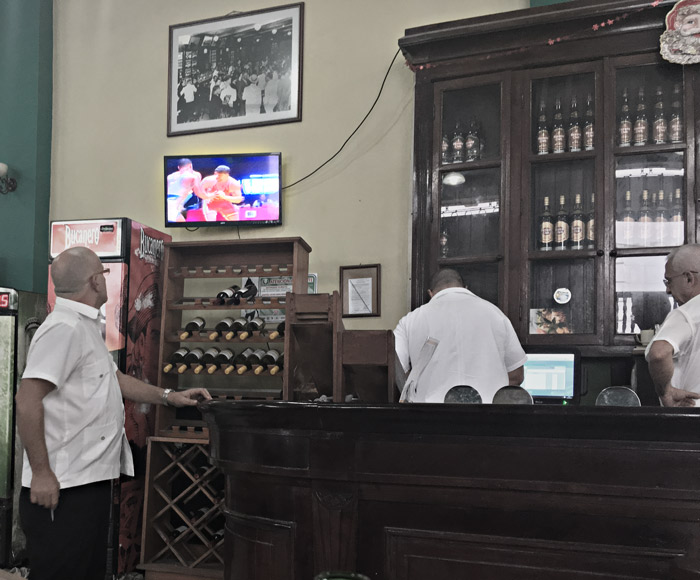 During a slow afternoon at a bar in Havana Vieja, one of the bartenders watches a Cuban national team wrestling match on tv. The Cubans are traditional powers in wrestling, boxing, judo, and other martial arts, often taking home dozens of Olympic medals.
During a slow afternoon at a bar in Havana Vieja, one of the bartenders watches a Cuban national team wrestling match on tv. The Cubans are traditional powers in wrestling, boxing, judo, and other martial arts, often taking home dozens of Olympic medals.
Below are scenes of training and competition at a youth wrestling program in downtown Havana, housed in an old Basque gymnasium. Photos by Alexandre Meneghini for Reuters.
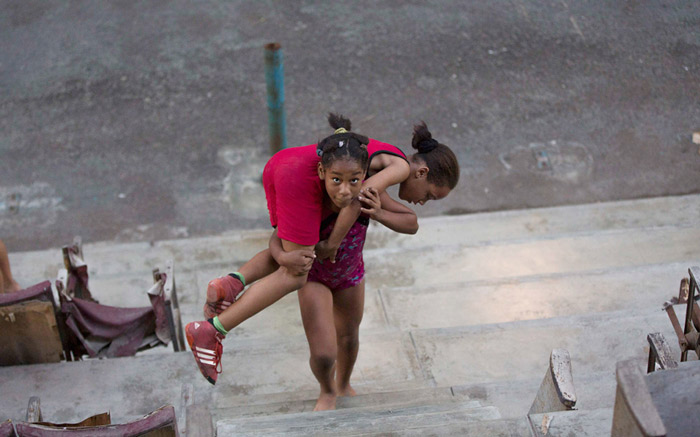
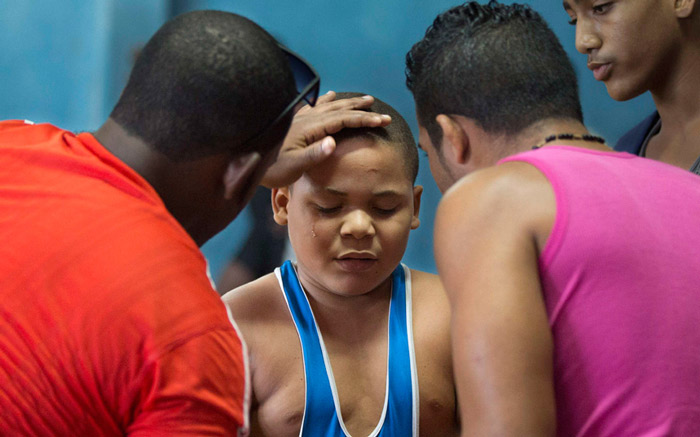
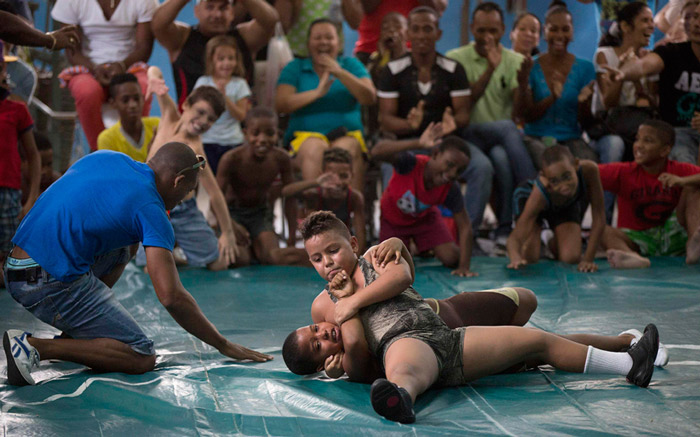
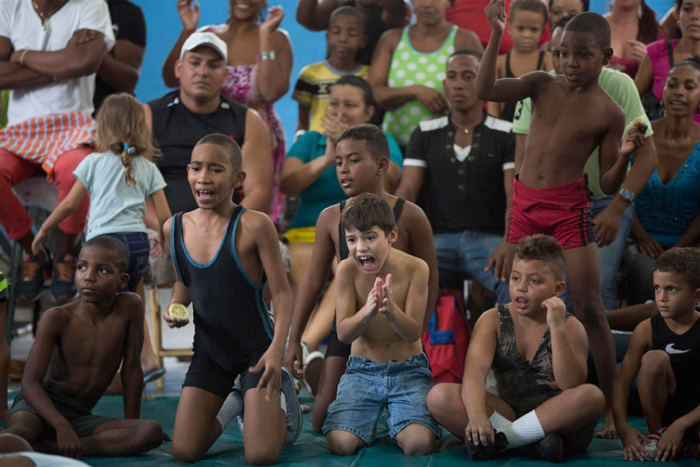
sports
wrestling
children
Havana
Cuba
competition
coaching
practice
cheering
training
(Image credits: top, my phone; others by Alexandre Meneghini for Reuters)




















 Hank, in yellow, was the "customer" of a company that embroiders custom designs, such as team logos, onto anything you can think of--in this case, a Rumblebee! embroidered on a headband. The Rumblebees played ultimate frisbee last summer in a county league. Recently, Hank noticed that the embroidery company was offering discounts and other rewards in return for customer photos of the embroidered items in action. He sent them this photo, and they sent him fifty dollars and put his picture onto the front page of their website.
Hank, in yellow, was the "customer" of a company that embroiders custom designs, such as team logos, onto anything you can think of--in this case, a Rumblebee! embroidered on a headband. The Rumblebees played ultimate frisbee last summer in a county league. Recently, Hank noticed that the embroidery company was offering discounts and other rewards in return for customer photos of the embroidered items in action. He sent them this photo, and they sent him fifty dollars and put his picture onto the front page of their website.


 Hank swings his way up the wall in the climbing gym. Rock climbing has become a passion of his lately, but he says that climbing in a gym is not nearly as pleasant and exciting as climbing cliffs and boulders outdoors in the fresh air.
Hank swings his way up the wall in the climbing gym. Rock climbing has become a passion of his lately, but he says that climbing in a gym is not nearly as pleasant and exciting as climbing cliffs and boulders outdoors in the fresh air. Every April, the town of Annapolis, Maryland, gears up for the annual croquet match between the Midshipmen of the Naval Academy and the Johnnys of the small liberal arts college across the street, St. John's.
Every April, the town of Annapolis, Maryland, gears up for the annual croquet match between the Midshipmen of the Naval Academy and the Johnnys of the small liberal arts college across the street, St. John's.

 When our four-year-old neighbor went to the baseball game Monday night, she got to wear her Phillies dress, and she got to hang out with her preschool buddy, who wore his Incredible Hulk shirt. And not only that, the Phillies beat the Dodgers.
When our four-year-old neighbor went to the baseball game Monday night, she got to wear her Phillies dress, and she got to hang out with her preschool buddy, who wore his Incredible Hulk shirt. And not only that, the Phillies beat the Dodgers.
 When I imagine a perfect Fourth, there would be water splashing in the afternoon, then hot dogs, watermelon, blueberry shortcake–or maybe boiled crabs, potato salad, corn on the cob–and finally sparklers and fireworks. In the air, at some point, there could be band music and lightning bugs and American flags.
When I imagine a perfect Fourth, there would be water splashing in the afternoon, then hot dogs, watermelon, blueberry shortcake–or maybe boiled crabs, potato salad, corn on the cob–and finally sparklers and fireworks. In the air, at some point, there could be band music and lightning bugs and American flags.



 John "JJ" Stein goes up for what we assume has got to be a basket in league play with Seattle's Jet City Hoops in the gym at the Asian Resource Center.
John "JJ" Stein goes up for what we assume has got to be a basket in league play with Seattle's Jet City Hoops in the gym at the Asian Resource Center.


 Juniper Self, shown here with her mother Daphne, came dressed to cheer at Bryant-Denny Stadium last week for her first Alabama football game. The Crimson Tide beat University of Tennessee–Chattanooga, 49–0.
Juniper Self, shown here with her mother Daphne, came dressed to cheer at Bryant-Denny Stadium last week for her first Alabama football game. The Crimson Tide beat University of Tennessee–Chattanooga, 49–0.




 The posture of number 6, who's been playing football this season for the Electrons of Ben Franklin High School, is ambiguous. Perhaps he's a kicker focusing on the ball on a tee; perhaps he's just unhappy about something in the game, or something unrelated to the game. Certainly, he's not celebrating.
The posture of number 6, who's been playing football this season for the Electrons of Ben Franklin High School, is ambiguous. Perhaps he's a kicker focusing on the ball on a tee; perhaps he's just unhappy about something in the game, or something unrelated to the game. Certainly, he's not celebrating.


